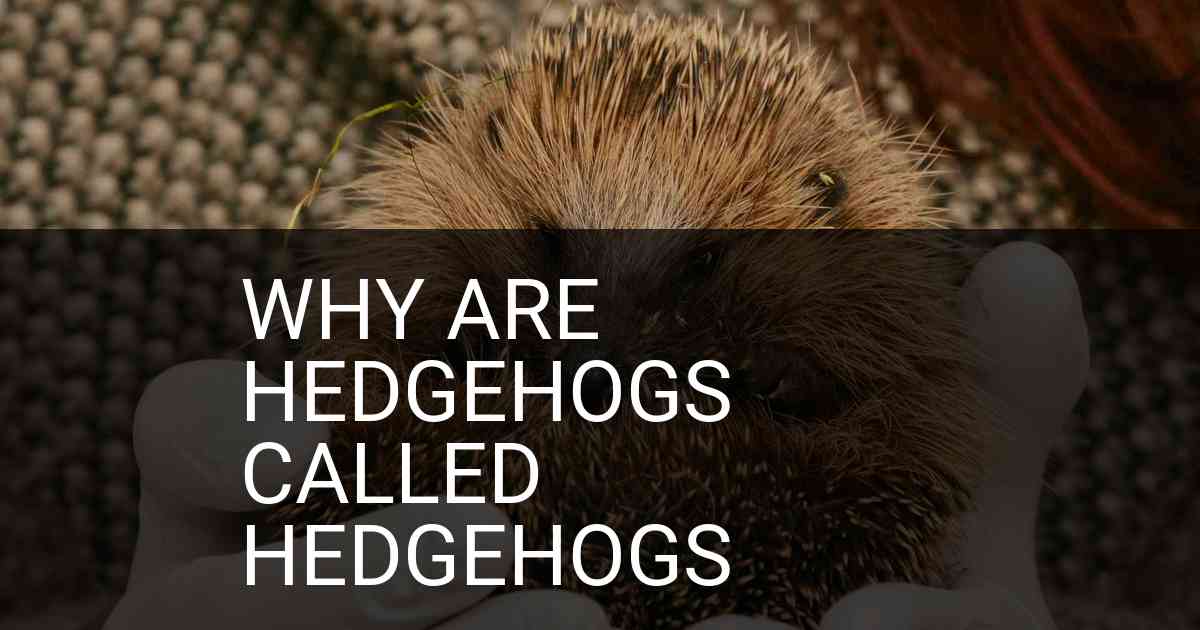
Hedgehogs are small, spiky creatures that have captured the hearts of people around the world. But why do we call them hedgehogs? Is it because they live in hedges or is there something more to the name? In this article, we will discuss where the name “hedgehog” comes from and explore some interesting facts about these fascinating animals. So if you’ve ever wondered why hedgehogs are called hedgehogs, read on to find out!
Why Are Hedgehogs Called Hedgehogs?
The word “hedgehog” is believed to have originated in English around the 14th century. It is likely derived from two old English words, ‘hecg’ meaning hedge and ‘hoeg’ meaning hog or pig. The combination of these two words gave us our current term for this prickly little mammal.
The name “hedgehog” aptly describes the animal’s natural habitat – living among thick hedges and shrubs. This provides them with protection against predators and shelter from harsh weather conditions. They are also known for their spiky coat of fur which helps protect them even further by making it difficult for predators to get a good grip on them.
Interesting Facts About Hedgehogs
- Hedgehog babies are called hoglets: A baby hedgehog that has just been born is referred to as a hoglet. Hoglets typically weigh between 10-20 grams and measure only 2-4 cm long when they are first born.
- Hedgehogs can run up to 6mph: When they feel threatened, they are able to reach speeds of up to 6 miles per hour in order to escape danger!
- “Hedgie Snuggles” Can Help With Anxiety: Many pet owners have reported that cuddling with their pet hedgehog can help relieve stress and anxiety levels.
- “Prickle Parties” Are Popular Among Pet Owners: It may sound strange, but some pet owners organize “prickle parties” where several hedgehog owners gather together so their pets can socialize with each other.
The Ancient Origins of the Hedgehog Name
The hedgehog is an adorable creature, recognizable by its spiky exterior and adorable behavior. But who gave them their name? The answer lies in ancient history.
The word “hedgehog” dates back to a time before writing was invented. It comes from two Old English words: “hecg,” which means “hedge,” and “hoeg,” which means “hog.” Combined, these words literally mean “hedge hog.”
Over time, the hedgehog’s scientific name has evolved as well. In Latin, they are known as Erinaceus europaeus – or European hedgehog.
Hedgehogs Through History
- “Hecg Hoeg”: These were believed to have been used by Saxons (people living in parts of Great Britain during early medieval times) to describe a small animal that made its home in hedgerows – hence the term ‘hedge-hog’.
- “Erinaceidae” : This scientific term for hedgehogs was first written down by Aristotle (384–322 BC). He called them this because he thought their long snouts resembled those of a mouse.
- “Hericius Europaeus” : This phrase was coined in 1758 by zoologist Carl Linnaeus to formally describe the species of hedgehogs found throughout Europe at that time.
Exploring the Link Between Hedgehogs and Pigs
Hedgehogs and pigs may seem like two very different animals, but they actually share many similarities. Both are small, omnivorous mammals that are found all over the world. They also have a number of other traits in common.
Behavioral Traits
Both hedgehogs and pigs enjoy rooting through piles of leaves or soil to find food. They also tend to be social creatures, living in groups with other members of their species. This behavior is exhibited by both hedgehog families and pig herds.
Physical Traits
Physically, hedgehogs and pigs look quite similar as well. They have short legs, stout bodies, snouts for sniffing out food, and some even have bristles on their backs. In addition, they both make use of their noses when searching for food or exploring new environments.
Other Traits
- Reproduction: Although breeding habits vary between species, both hedgehogs and pigs typically reproduce sexually.
- Diet: Both animals mostly feed on insects and invertebrates as well as fruits and vegetables.
- Lifespan: The average lifespan for a wild hedgehog is about six years while domestic pigs can live up to 15 years depending on the breed.
5 Fascinating Facts About Hedgehogs
Hedgehogs have been around for over 15 million years and are a beloved pet all over the world. Here are some interesting facts about hedgehogs that you may not have known:
- Hedgehog spines are made of keratin, just like human fingernails. This makes them very sturdy and helps protect them from predators.
- Hedgehogs can run up to 6 miles per hour! They also love exploring and sniffing out new things in their environment.
- Hedgehogs use their strong sense of smell to find food. As insectivores, they enjoy snacking on worms, slugs, grubs, beetles and other bugs.
- Hedgehogs make excellent pet companions. Unlike many small pets, they only need minimal social interaction with humans. They also don’t require regular grooming or bathing which is great for busy owners!
- Hedgehog babies are called hoglets. Hoglets typically weigh 5-7 ounces at birth and can grow up to 1 pound when fully grown.
Conclusion
In conclusion, the origin of hedgehogs’ name is not clear. However, many believe that the animals were named because they often seek out and live in hedges or other areas with dense vegetation. Others think it may have been related to their habit of snorting like a pig while foraging. Whatever the true origin may be, these small mammals are certainly an interesting part of nature and deserve respect from us all.

